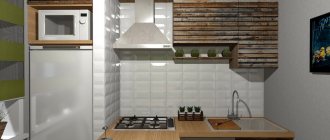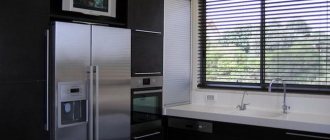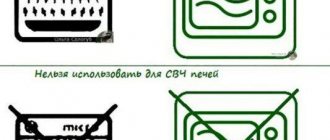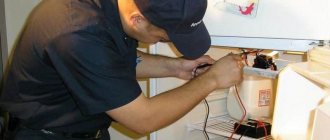The usable area of kitchens in old houses or modern small families often does not exceed 5-6 sq.m. Therefore, when purchasing household appliances, many people have doubts about their correct placement. Advice from experts will help you figure out how to place a refrigerator next to a heating radiator: is it possible or not, what should be the distance to heating devices, how to avoid overheating and damage to an expensive device.
What to do if the layout of the room does not allow placing this equipment in another place
We have already found out whether it is possible to place a refrigerator next to the radiator or not, but if you did not take this point into account and remembered this technique only after completing the kitchen layout, you should take care of safety measures. Below we note several rules that can protect your refrigeration equipment from sudden breakdowns:
- The distance from the heating radiator should be as large as possible. It is unacceptable for the back of the refrigerator to come close to the battery.
- It is recommended to install the refrigerator near the radiator not from the back, but from the side. This is done so that the electric motor does not heat up so significantly during operation (and even without the participation of the battery, its temperature is very high).
- A thermal insulating partition (heat shield) should be made between the heat source and the refrigerator, which will reduce the heating level of equipment parts. In this case, this element must be covered with foil on both sides.
Is it possible to install the equipment with the back facing the heating?
Installation with the back side facing the radiator is the most dangerous and unsuccessful. The grille of the appliance, whose main function is cooling, will heat up. The compressor will quickly break down, and buying a new one will be very expensive.
With this placement of the device, the radiator will be completely closed. The room will not receive the necessary heat. The air temperature will become much cooler due to the fact that the heat will be used to heat the equipment.
The only feasible solution is to relocate the radiator itself.
Way out
If the only possible place in the kitchen is next to the heating system, care should be taken to protect the appliance and extend its service life. There are several points that must be followed in order for the device to stand next to the battery:
- Under no circumstances should the back wall be placed close to the heat source;
- It is desirable that the battery occupies only part of the side wall for the normal functioning of the electrical appliance;
- Make a partition or screen, place foil on top, and place it between the radiator and the refrigerator. This method will help insulate the heat. You can use self-adhesive penofol on the side wall of the electrical appliance. Foil serves to reflect heat flows, penofol serves to absorb heat.
Correct location
When installing equipment, you need to know what distance should be from the refrigerator to the battery. You can determine what distance should be from a household appliance to heating systems using the following standards:
- From the battery or pipeline system with hot water to the walls of the refrigeration device, maintain at least 50 cm.
- The equipment is placed so that its side wall is at least 30 cm from the battery.
- The refrigerator should not be installed with its back wall facing heating appliances or an electric stove.
- The device can only be placed near an electric stove or oven if there is a partition with a heat-insulating layer.
- You need to know how far the refrigerator should be from the window. If placed close, direct sunlight will fall on the equipment, overheating its elements. The household device will spend more electricity on cooling, which will lead to its breakdown.
- Experts recommend adjusting the air flow at the bottom of the refrigerator. To do this, you will need to tighten the legs of the device to a height sufficient for safe operation or make stands.
- The floor surface must be level for stable operation of the cooling system of household appliances.
- When a heating pipe is placed under the floor or a “warm floor” system is installed, the refrigerator is moved to the loggia. It is optimal to determine the location for the unit before carrying out repair work and not plan floor heating in this area.
- For long-term operation of a household device, it is important to consider the following requirements:
- the room must be ventilated regularly to maintain stable humidity characteristics;
- the permitted distance from the refrigeration unit to the ceiling is 10 cm for safe use;
- the device must be placed level or tilted back no more than 2° (in this case, the doors will be closed hermetically).
What should be the distance
The kitchen is considered a special place in the house; not only its appearance, but also its convenience depends on its layout. Therefore, the correct placement of household appliances in the interior plays a huge role, in particular this applies to the location of the refrigerator. In some cases, lack of space forces many owners to place the refrigerator near the stove. In order to protect it from the negative effects of high temperature, you need to know the minimum location distance, and of course, it is recommended to additionally make a protective barrier in the form of a built-in cabinet.
The refrigerator is externally insulated, so its location next to a gas stove will not in any way affect the temperature inside, but when the surface of the appliance starts to get very hot, the unit will work in enhanced mode. As a result, not only electricity consumption will increase, but also the load on the compressor itself, which in turn will significantly reduce the service life of the device. To maintain a constant microclimate and uniform cooling of the refrigerator, it is necessary to ensure the maximum distance between the refrigerator and the gas stove. Otherwise, compensation will be observed for the heating of that part of the device that is located near the stove. The second part of the refrigerator, which does not require cooling, will begin to freeze ice. Such temperature changes are not in favor of stored products.
During the cooking process, residual fat will scatter onto its surface. Therefore, with such a “neighborhood”, you will have to wash the refrigerator several times a day. To avoid this, you need to place a separating object between the appliance and the gas stove: a table can be an excellent option. In addition, having a kitchen table will make it much easier to remove and put away food.
The minimum distance between equipment is 20 centimeters. However, this figure may change according to the recommendations of manufacturers, who have certain standards for each model. Thus, the manufacturer Bosch advises installing the stove at a distance of 30 centimeters, and Zanussi prescribes as much as 50 centimeters.
A similar location problem also applies to built-in ovens or just ovens. The instructions for any refrigerator say that it is strictly forbidden to install it next to heating equipment, and the oven and oven are sources of heating. Therefore, the distance between them should be at least 50 centimeters. Of course, manufacturers additionally equip the refrigerator with insulation, but it is designed for operation of the device at normal temperatures.
In addition, in order for the products to be cooled to the required temperature, the device will have to work harder and use much more electrical energy. Such a situation will speed up the breakdown of the refrigerator, and its incorrect placement may cause a refusal of warranty service from the service company, since the user did not comply with the main operating conditions. Despite this, today in many small-sized kitchens you still have to find an oven and a refrigerator next to each other. To protect devices as much as possible, many people lay a layer of thermal insulation between them, but this does not give a significant result. In this case, it is best to use built-in household appliances. Thus, the oven is insulated with wooden walls, and the heat is removed using a hood.
This installation causes heating of the device and negatively affects the operation of the compressor, which has to work in increased mode to replenish the necessary cold. And this is not only high energy consumption, but also rapid wear and tear of the equipment itself. Under the influence of high temperatures, the outer enamel of the refrigerator may also crack, and the beautiful white surface will quickly become covered with traces of grease, as a result there is no need to talk about its aesthetic appearance.
If we consider safety precautions, installing a refrigerator next to an electric stove is also not allowed. Excessive overheating will negatively affect the operation of the device, and a non-standard microclimate will cause a fire. Any source of heat is bad for the device. In the case where the kitchen area does not allow for special arrangement of equipment, then you need to at least maintain a distance of one and a half meters between the refrigerator and the electric stove. It is also recommended to additionally install a protective shield or thermal insulation partition between the equipment.
How can I fix the situation?
The ideal arrangement of kitchen equipment is achievable if you have a large space, which not everyone has yet. It is difficult or impossible to achieve compliance with the triangle rule - so that the stove, refrigerator and radiator are located in three different corners, and between them there are tables, sofas and cabinets in a tiny kitchen.
Taking the unit into a narrow corridor or placing it in a living room is also not an option. This will cause a lot of inconvenience and will also disturb those who are light sleepers. The housewife, who will have to run far for the necessary products, will also not be delighted with this idea.
People get out of the situation by installing an additional hood on top of the refrigerator, making a duct into the air conditioning system, putting a rattan or polymer cover on the battery, which prevents the spread of heat and increased load on the motor.
A protective box or foil screen installed between the electrical appliance and the heat source helps.
In the most critical cases, a mini-stove or a sink for smaller dishes is purchased. But the ban on installation near a radiator has too strong grounds for it to be ignored. The cost of a new motor and its installation can cost half the price of a refrigerator, and the first thing that suffers when adjacent to the radiator is its engine.
Best answers
Alexander:
If a simple cold, i.e. with a capacitor on the outside (visible), then it is possible if it (cold) stands with its side wall facing the battery. In this case, it is enough to glue a layer of heat insulator, for example PENOFOL, onto the side wall facing the battery. It cannot be placed on the back side, because in this case, the compressor will overheat and turn off faster - you won’t get cold inside. If the refrigerator is “hidden”, i.e. and the condenser and evaporator are not visible, then in this case it is generally not recommended to place it near heating devices, because the capacitor in this case is located inside the side walls; There’s a compressor at the back, but there’s no way to put one in front...
Ches:
It’s not desirable, but I had one and it was okay, now there’s another one in the same place, a new one, but the old one has served its purpose, it’s 20 years old, although it’s still plowing!
Autobox:
– Are there rules for installing a refrigerator in the kitchen? Any instruction contains rules for installing the appliance. It is not recommended to install the refrigerator closer than five centimeters from walls and furniture and near heating appliances, for example, near radiators, because there is an additional flow of heat to the refrigerator. The motor-compressor turns off when a certain temperature is reached in the refrigerator or freezer compartment. It may happen that the heating device will influence the operating mode of the refrigerator so much that it will disrupt its normal operation, the refrigerator will work harder, and the food will cool worse. In modern refrigerators, which use special heat-insulating materials, such as polyurethane foam, the walls are reliably protected from external heat influx, so the question of the possibility of placing the refrigerator near heating devices can be ignored.
Evgeny Orekhov:
if you think like that, then both its hot engine and radiator grille should be installed at your neighbor’s
solomon101:
Can. And then change it every six months for a new one.
Ruslan:
If there is nowhere else, then between the battery and the back wall of the storage room you need to install a heat insulator-screen, for example, foam plymer with foil.
Ruslan Kharchenko:
Modern refrigerators are not afraid of batteries, feel free to install them!
Sergey:
possible but not advisable
Alexander:
depending on what battery and what kind of refrigerator.
Ideas for placing a refrigerator
Even in a small kitchen, it will be possible to place the refrigerator so that it does not stand near the radiator. For example, you can choose a unit of a non-standard size. Narrow and tall will allow you to store a sufficient amount of food, and will take up less space. Another option is a built-in refrigerator. The height of this equipment allows you to install shelves on top for storing kitchen utensils. There are also very small models that are installed under the work surface. They usually do not have a freezer, but it can be placed separately, also under the countertop. True, such a compact unit is suitable only for a very small family.
Why not
Placing a household appliance in direct sunlight, as well as close to stoves, negatively affects its performance, as the compressor speeds up, starts working longer, consumes more electricity and increases wear. Often the small volumes of the kitchen leave no choice for the owners; they have to place the refrigerator next to other kitchen appliances. Of course, such an arrangement is unacceptable, but thanks to the availability of modern technologies, you can easily provide the refrigerator with reliable thermal insulation, which will protect the unit from overheating and normalize the heat transfer process.
Alternative options
If there is no suitable space in the kitchen, you can choose an alternative installation option to extend the life of the technical device and free up space.
The list includes the following options:
- Placing the device in the pantry will save space in the kitchen. There is no air overheating in this room, because supplies and things are stored. The shelf life of the refrigeration unit can be extended. There should be an electrical outlet in the pantry or next to this room.
- A glazed loggia or balcony is a comfortable option for installing a refrigerator. The most convenient loggia is the one adjacent to the kitchen. However, it is important to consider that the room must be heated.
- In small apartments, you can move the household unit into a spacious corridor or hallway. You can allocate space in the closet for a compact refrigerator. The advantage is the close location of the kitchen, stable low air temperature.
- In some cases, it is recommended to place the device in the dining area; there is good air circulation in the room; the equipment will work for a long time.
Tips for choosing a freezer
You shouldn’t get hung up on a certain model just out of respect for the country of origin, a previously favored brand that gained trust due to the long-term use of the previous model.
Furniture and appliances in the kitchen
If it's about saving space, it may be worth looking at a narrower model from a trusted designer rather than skimping on the recommended distance from the wall to the refrigerator. Deviations from the required standard quickly lead to the need for repairs, and if it is determined that the breakdown is due to improper operation, repairs can be very expensive.
Important nuances when planning a kitchen
In order to create a comfortable environment in the kitchen, design experts advise using the win-win “triangle” rule. All kitchen equipment should be installed in 3 corners of the room; the most suitable option is to connect a gas stove, a dishwasher and refrigeration equipment.
This placement of all elements is the most successful. In addition to safety, it creates a comfortable space for work. In this way, you can create an overall comfortable multifunctional complex, which is equipped with the necessary work surfaces, cabinets, and shelves.
Opinion of owners of small kitchens
Many owners of small apartments have encountered the problem of properly installing a refrigerator. In a small kitchen there is not always free space, and the only available option is near the radiator. In order not to expose the unit to excessive overheating, the owners try to make a partition from heat-insulating material. Thus, they protect the device from premature failure.
The opinion of owners is not always clear: some believe that a refrigerator has a place in the kitchen, while others believe that it can be placed in another room. Typically, residents prefer the hallway or hall because they are in close proximity to the kitchen. Occasionally, the refrigerator is installed in a pantry, where the ideal temperature is always maintained, and the unit is not affected by thermal radiation.
Basic moments
Before purchasing a refrigerator, you should consider delivery issues - hire a vehicle of the appropriate size, measure the elevator doors, entrance and kitchen door openings so that the unit can be brought into the room without any problems. If you transport the device by placing it on the door or back wall, the compressor may come off and the freon may not flow properly, which can cause an air bubble to form and the system’s tightness may be compromised.
In winter, the distance of the device to the wall should be about 5 cm.
The most important installation rules:
- you need to place the refrigerator away from the sun and drafts, but where there is sufficient movement of air masses;
- in winter, the distance from the wall to the back wall of the unit is about five centimeters, in the summer it is moved back another three to five;
- the further the refrigerator is placed from any heating devices, the better, but it is not advisable to place it exactly opposite a gas, electric stove, heating radiator, etc.;
- Items such as a washing machine, any other electrical appliances (coffee maker, microwave oven, toaster, etc.) must not be installed in close proximity to the item;
- the refrigerating cabinet is placed at the same distance from various pieces of kitchen furniture;
- You should not connect the refrigerator through an extension cord or tee - it is permissible only through a stationary outlet.
Other household appliances are not allowed to be installed close to the refrigerator.
Basic rules for successful design
Draw a general view of the interior and plan
Start with space planning. Visually and accurately arrange all the interior elements on a sheet of paper or in a computer program. Think about how to make this room convenient, practical and comfortable for all family members. The following interior design rules will help with this.
Rule 1: zone your kitchen comfortably
If we talk about comfort and functionality in the kitchen, then it is necessary to highlight three zones that the housewife usually, or rather often, uses.
- Wash area
(with cupboard). - A hob
with a worktop next to it. - Refrigerator
(near the grocery cabinet and work desk).
Even a small kitchen needs to be zoned
Incorrect placement: the stove and sink are on the same line, but the refrigerator cannot be placed near the stove.
Let's look at how to install a refrigerator in the kitchen according to zoning rules. It can even be installed near the opposite wall if the room is small. Just remember that the distance to the refrigerator from other areas should also not exceed one and a half meters.
The refrigerator cabinet also looks stylish in the center of the wall if combined with other appliances
Of course, various factors will have to be taken into account. Namely:
- dimensions and geometry of the kitchen space (more on this later);
- window dimensions - the refrigerator should not cover it;
- balcony door – it is better to place the set with a refrigerator along the wall;
- Is the kitchen combined with another room - here you can come up with a lot of options.
Rule 2: Place the refrigerator rationally
Harmonious design – a refrigerator “built-in” into the kitchen furniture
Manufacturers of refrigeration equipment currently offer a huge range of models. Therefore, choosing this household appliance of a suitable configuration for your own kitchen is not difficult.
Option for a small room - under-counter refrigerator
Rule 3: create a harmonious interior design
The unit must be selected in such a way that it fits exactly into the interior. Installing a refrigerator in the kitchen is, in principle, simple. Here you can rely on your own taste preferences.
Harmony with the overall interior and furnishings is welcomed
The matter, of course, concerns not only color design, although this criterion is also important. You will have to clearly fit the refrigeration unit with your own hands, taking into account the overall design of the room, furniture and other accessories.
Therefore, each of us chooses a refrigerator according to the principle:
- Built-in model. There is always an opportunity to hide the refrigerator and make it invisible.
- Art object. Put it on display, making it one of the accent objects of interior design.
The metal surface is a bright design accent
Based on these principles, the following options are being considered:
- the unit will hide in a niche, between furniture elements, or under a cladding similar to the set;
- will be displayed when placed separately from furniture (near the door, against the wall opposite the cabinets).
Why manufacturers do not advise placing a refrigerator next to a radiator
To create frost inside the refrigerator, a refrigerant (freon) is used.
It circulates through the system. Freon enters the freezer at the most optimal temperature, capable of freezing the food in it. Food supplies when placed in the refrigerator are usually at room temperature. When cooling in a confined space, food needs to give up its heat. Freon takes it away when it begins to boil under pressure in the evaporator. When boiling, this substance gives off its cold, and accumulates all the heat in itself.
Then the refrigerant needs to get rid of it too. This happens when, moving through the system, it leaves the chamber and enters the condenser located on the back wall of the refrigerator.
Rice. 1. Heat removal principle
Moving in a spiral on its way to the compressor under a different pressure, freon gives off heat to the surrounding atmosphere and becomes liquid again. In this state, its temperature drops as much as possible, and it is ready to enter the evaporator again, where it will again give up its cold and take away some more heat from the food.
The process continues until the programmed relay operates. When the temperature in the chamber reaches the set norm, the pump (compressor) stops working. If the temperature in the freezer rises, the process will resume. This principle gives the compressor motor a rest. At the same time, the energy consumption is significantly reduced.
If the hot condenser grille is forced to be heated from the outside (this is what happens when the radiator is running), freon will not be able to completely lose heat. The refrigerant will enter the evaporator not cooled to the optimal temperature.
Rice. 2. Optimal distance between the heat source and refrigeration equipment
This will cause the chamber to take much longer to reach the desired degrees. And in some cases, the compressor will operate without interruption at all. But even here there is a possibility that the desired temperature will not be achieved.
All this will affect the future quality of the products. And a compressor, designed for many years of service with proper operation, will fail much earlier than expected.
Material on topic! Transporting a refrigerator lying down - is it possible or not?











